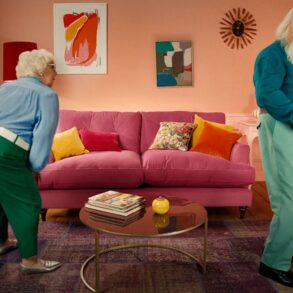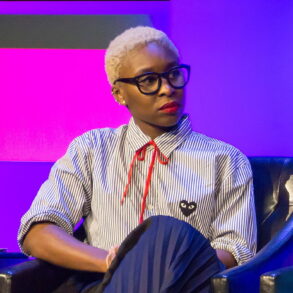Chingy follows me on Instagram. Yep, the “One Call Away” rapper from St. Louis that we all had crushes on in the early 2000s bumped my follower count in 2018. I had just shared a clip of the “Right Thurr” music video on my Instagram Story and noted how it was one of the first times I saw women with legs as thick as mine on television. As a young teen, watching these models strut along a Missouri sidewalk in shorts with their thunderous thighs on full display as Chingy and his friends salivated made me feel better about my legs, the part of my body I’ve always been the most unkind to. Those scenes helped me believe that someday my own opulent piernas would elicit the same kind of desire from admirers.
In my post, I thanked Chingy for including full-figured vixens in his music videos, and, unpredictably, he later sent me a direct message saying, “No, thank you, sweetheart” (*swoon*), gave me a follow, and double-tapped on some of my own thirst traps.
For years, Latinas like Jennifer Lopez, Sofía Vergara, and Salma Hayek have been celebrated for refining the standards of beauty by gracing our TV screens with larger derrières and/or breasts than their non-Latine white contemporaries. Many felt seen in these slightly curvier bodies, and I love that for them, but I never did. Sure, like these women, I too am light-skinned with long brown hair. But unlike them, I’ve never been skinny. My buxom breasts and backside are also accompanied by fat on my arms, belly, and legs. Women who looked like me weren’t in Hollywood. Instead, they were in rap and R&B music videos: the Black and Latina video vixens of the early aughts.
For me, these were the starlets who were challenging beauty standards, embracing every aspect of their physical and sexual identities, and inspiring young women to do the same. Every time I saw Melyssa Ford, Esther Baxter, Gloria Velez, Vida Guerra, Bernice Burgos, or Rosa Acosta, to name a few, on-screen, swirling their ample hips for the camera or seductively sauntering away from Jay Z, 50 Cent, the Dipset crew, or some other rap star of the time, I felt like I could navigate through life as confidently as them. It made me feel like my body, the one I was punishing by refusing to feed it, could be both desirable and powerful as it was. Oftentimes, they even had me, an evangelical Christian virgin, considering a career as a video vixen. These models weren’t mere sexpots to me. They were fully embodied, self-assured, and autonomous women — and I wanted in.
The rest of the world didn’t see video vixens this way, though. At the time, many of the rappers and directors who hired the models for the music videos viewed them as nothing more than objects to be displayed, consumed, and discarded. Their work behind the scenes, building their own wardrobes and helping directors create concepts and construct aesthetics, were often uncredited. Instead, some of the musical acts who slept with the women (or who wanted to but couldn’t) disparaged them in their lyrics or interviews. Most infamously, The Game took a jab at Ford in his 2006 song “Wouldn’t Get Far.” In it, he raps, “they don’t know Melyssa Ford drive a Honda Accord / She a video vixen / but behind closed doors, she do whatever it take to get to the Grammy Awards.” In a 2019 conversation with Claudia Jordan’s “Out Loud,” Ford said that the line had a devastating impact on her wellbeing. “That song destroyed my relationship because of the way people talked about me,” she said. “… I didn’t even know Game. I only met him once when he was one of 50’s G-Unit soldiers. All of this was my cross to bear and it was so difficult because no one stood up for me. No one defended me.”
And it wasn’t just the hip-hop industry. Audiences derided video vixens, shaming them for making money by playing to the male gaze. Whether rooted in misogyny, jealousy, or both, these women were hated for daring to celebrate their body and sexual freedom on-screen, for the world to see.
But for me, and a generation of young Latina and Black women, these models offered representation and empowerment. While my dreams of becoming a video vixen never manifested, I channel their self-confidence, autonomy, and allure regularly, whether taking sexy photoshoots or videos for lovers or simply existing as a shapely woman in a fatphobic culture. And I’m far from alone. Even now, decades after the height of the video vixen, Gen Z creators are also influenced by the women in these 2000s music videos, recreating their iconic looks and dance moves in trending TikTok clips.
@lordjesusitsafire They used to eat though! I wanted to be one so bad 😂😂 #fypツ #foryou #videovixens #y2k #y2kaesthetic #dance ♬ original sound – RealRiddimsHH™
To celebrate these unsung cultural heroines, we speak with some Latinas who felt seen and inspired by video vixens.
Gloria Malone
I grew up across three different states in the United States. In all of these states, non-Black women were the beauty standard. It led to me incorrectly thinking I wasn’t gorgeous for many years. As a ‘90s and 2000s kid, we had terrible representation of beauty and bodies everywhere. Even skinny white girls weren’t skinny enough. And I knew that I wasn’t white, so the image of white beauty was never something I could magically obtain. But Black video vixens and models showed me someone who I could grow up into, someone with a booty, some hips, big hair, and my skin color. It showed me that Black women can and were gorgeous, stunning, and hot, too.
At a baseline, video vixens confirmed that Black women deserve all of the episodic things shown in the music videos. Seeing Black women in music videos helped me see that we are worthy of praise, dramatic rain scenes, fun parties, comfort, and joy.
I think about how Black video vixens were also popular around the same time Black media had unambiguously Black women in a number of shows. It felt like the shows and the music videos were reflecting the reality that Black women can be any and everything we want to be. It showed me that Black beauty and femininity should be celebrated and highlighted. Other media didn’t show Black women in multi-dimensional ways, so I feel music videos offered another side of the representation story.
Women are always deserving of their flowers, period. Living in a male-dominated and constructed world is really hard. These women were trailblazers, and not just because they were hot. I think they deserve their flowers because they added to musical stories and, more times than not, made the stories. A man crying in the rain in silk pajamas is weird; it’s not a story. But seeing the hot woman he fumbled, a woman who made his life sunshine, and then seeing him crying in the rain in silk pajamas helps you understand how devastated he is. The truth of the matter is video vixens made videos, and these visual narratives were worth tuning into.
Carla Peterson
I grew up in Central Florida. In my early childhood, all the representation I needed was within my family and community, just seeing us out and about in our plurality. But as I got older and tapped into mainstream media like MTV and BET, I rapidly gravitated toward the beauty of the video vixen. I think that I found the closest representation to what my shape was in them. Oftentimes, their hair was curly and they accentuated their skin tones with glowy bronzers, which was the opposite of trying to white-wash their identities. Watching them helped me, and so many friends, tap deeper into my natural beauty. I remember recreating whole looks from videos. I’d try to get the same outfits and do my hair and makeup like them.
I’ve always been plus-size, and when you are fat in Latine culture, you are constantly judged by your elders. But in this imagery, my body was celebrated, and these women were spoiled, idolized, and seen as the ideal. Watching this brought a lot of relief to my body image. The way they walked looked like me, and the way things looked when they sat down looked like my body. The way they danced and moved put watchers in a trance, and that filled me with courage. It was empowering.
I feel it helped me lean into a well of confidence. These women were ogled, spoiled, and sought out. I don’t think that the confidence I have now could have evolved if it weren’t for the influence of video vixens. The dark side of this learned confidence is that for a long time male approval persuaded my confidence. The direct correlation of “am I hot?” depended on whether my crush at the time said so. Watching the rappers dotting on women, I know I interpreted that as the ultimate compliment and proof that I was attractive. I have since learned and evolved from such a male-led perspective. Years of working on true self-confidence taught me it is me who has to think I am fine as hell and so it shall be. It boils down to showcasing my body and boldly being proud of it. It’s radical.
Annell Lopez
As someone who grew up in the Dominican Republic and, later, New Jersey watching telenovelas, the video vixens in rap and R&B music videos gave me the representation I didn’t get from shows on Univision or Telemundo, for instance. Most Spanish-speaking TV centered on white or fair-skinned Latinas who looked nothing like me. These fair-skinned Latinas were also smaller and thinner. I didn’t feel like they represented me.
I really saw myself in those music videos: pretty girls with dark skin and more voluptuous bodies. This was important because, as a teenager learning how to love myself, representation was everything. These women looked authentic to me. They looked like me, and they looked like my friends. They were beautiful but also ordinary, which was particularly appealing at the time. They were one of us, so to speak, and we were one of them.
Because of the pervasive anti-Blackness I experienced growing up, I enjoyed how these women were desired and wanted. It made me feel like I could be considered beautiful and desirable, too. Seeing these video vixens made me feel seen. They made me feel like my aesthetic and appearance were attractive, beautiful, and desirable. When you’re young and still figuring out your sense of self, representation matters so much.
This post was originally published on this site be sure to check out more of their content.






